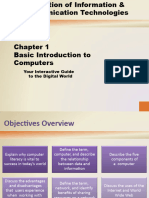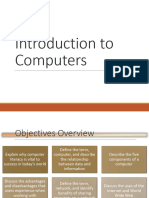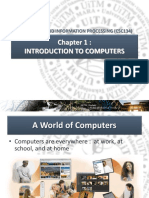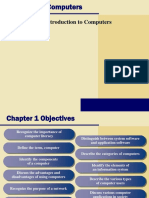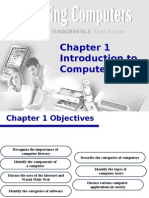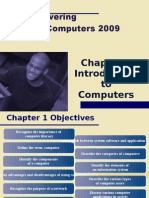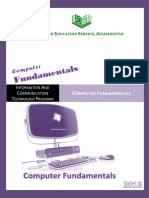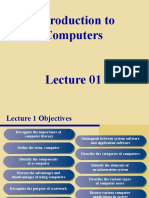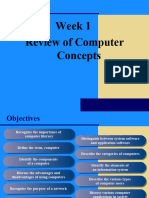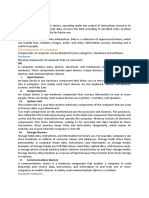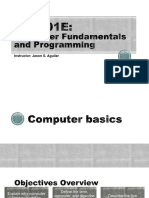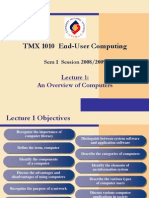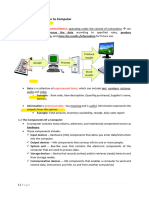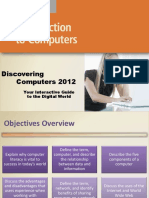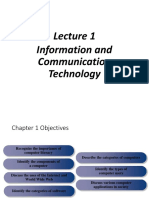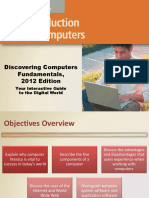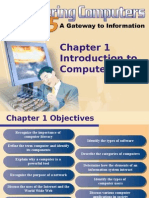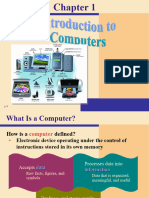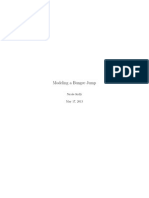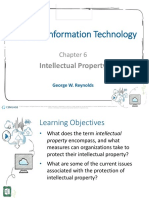Discovering
Computers
Your Interactive Guide to
the Digital World
�A World of Computers
• Computers are everywhere
Pages 4 - 5 2
Figure 1-1
�What Is a Computer?
• A computer is an electronic device, operating
under the control of instructions stored in its own
memory
Collects Produces
data Processing information
(input) (output)
Information Processing Cycle
Page 6 3
�What Is a Computer?
Page 6 4
Figure 1-2
�The Components of a Computer
• A computer contains many electric, electronic, and
mechanical components known as hardware
Input Device • Allows you to enter data and instructions into a computer
Output Device • Hardware component that conveys information to one or more people
• Case that contains the electronic components of the computer that
System Unit are used to process data
• Records (writes) and/or retrieves (reads) items to and from storage
Storage Device media
Communications • Enables a computer to send and receive data, instructions, and
Device information to and from one or more computers or mobile devices
Pages 6 - 8 5
�The Components of a Computer
Page 7 6
Figure 1-3
�Advantages and Disadvantages
of Using Computers
Advantages of Disadvantages of
Using Computers Using Computers
Speed Health Risks
Reliability Violation of Privacy
Consistency Public Safety
Storage Impact on Labor Force
Communications Impact on Environment
Pages 9 - 10 7
�Categories of Computers
Personal computers
Mobile computers and mobile devices
Game consoles
Servers
Mainframes
Supercomputers
Embedded computers
Page 19 8
�Personal Computers
• A personal computer can perform all of its input,
processing, output, and storage activities by itself
• Two popular architectures are the PC and the
Apple
– Desktop computer
Pages 19 - 20 9
Figures 1-15 - 1-16
�Mobile Computers and Mobile Devices
Mobile Mobile
Computer Device
Personal computer you Computing device small
can carry from place to enough to hold in your
place hand
Examples include smart
Examples include
phones and PDAs, e-
notebook computers,
book readers, handheld
laptop computers,
computers, portable
netbooks, ultra-thins,
media players, and
and Tablet PCs
digital cameras
Pages 20 - 23 10
�Mobile Computers and Mobile Devices
Notebook computer
Tablet PC
Smart phones and PDAs
E-book reader
Pages 20 - 22 11
Figures 1-17 – 1-20
�Mobile Computers and Mobile Devices
Handheld computer
Portable media player
Digital camera
Pages 22 - 23 12
Figures 1-21 – 1-23
�Game Consoles
• A game console is a
mobile computing
device designed for
single-player or
multiplayer video
games
Page 24 13
Figure 1-24
�Servers
• A server controls access
to the hardware,
software, and other
resources on a network
– Provides a centralized
storage area for
programs, data, and
information
Page 25 14
Figure 1-25
�Mainframes
• A mainframe is a large,
expensive, powerful
computer that can
handle hundreds or
thousands of connected
users simultaneously
Page 25 15
Figure 1-26
�Supercomputers
• A supercomputer is the fastest, most powerful
computer
– Fastest supercomputers are capable of processing
more than one quadrillion instructions in a single
second
Page 25 16
Figure 1-27
�Embedded Computers
• An embedded computer is a special-purpose
computer that functions as a component in a
larger product
Consumer Home Automation Process Controllers Computer Devices
Automobiles
Electronics Devices and Robotics and Office Machines
• Mobile and digital • Thermostats • Antilock brakes • Remote monitoring • Keyboards
telephones • Sprinkling systems • Engine control systems • Printers
• Digital televisions • Security modules • Power monitors • Faxes
• Cameras monitoring systems • Airbag controller • Machine • Copiers
• Video recorders • Appliances • Cruise control controllers
• DVD players and • Lights • Medical devices
recorders
• Answering
machines
Page 26 17
�Embedded Computers
Page 26 18
Figure 1-28
�Elements of an Information System
Hardware Software Data
People Procedures
Page 27 19
�Elements of an Information System
Page 27 20
Figure 1-29
�Examples of Computer Usage
Home User Small Office/Home Mobile User
• Personal financial Office User • Connect to other computers
management • Look up information on a network or the Internet
• Web access • Send and receive e-mail • Transfer information
• Communications messages • Play video games
• Entertainment • Make telephone calls • Listen to music
• Watch movies
Pages 28 – 31 21
Figures 1-30 – 1-32
�Examples of Computer Usage
Power User Enterprise User
• Work with multimedia • Communicate among
• Use industry-specific employees
software • Process high volumes
of transactions
• Blog
Pages 31 – 32 22
Figures 1-33 – 1-34
�Computer Applications in Society
Education
Finance
Government
Health Care
Pages 34 - 36 23
Figures 1-36 – 1-39
�Computer Applications in Society
Science
Publishing
Travel
Manufacturing
Pages 36 - 38 24
Figures 1-40 – 1-43
�Summary
Basic computer Components of a
concepts computer
Many different
categories of
Networks, the Internet,
computers, computer
and computer software
users, and computer
applications in society
Page 39 25
� Discovering
Computers
Your Interactive Guide to
the Digital World
